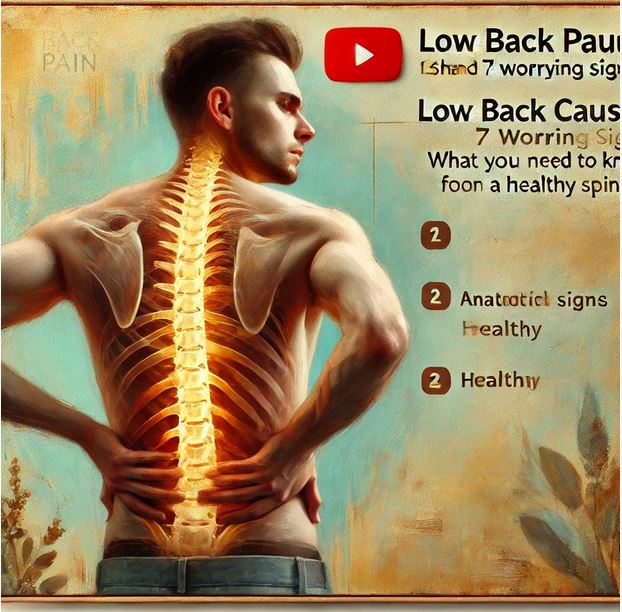Your Cart is Empty
Low Back Pain Causes (and 7 Worrying Signs) | What You Need to Know for a Healthy Spine
22 Jan, 2025 13

Low Back Pain Causes (and 7 Worrying Signs)
Low back pain is one of the most common health complaints worldwide, affecting millions of individuals at some point in their lives. It’s so prevalent that it’s often dismissed as an unavoidable consequence of aging or an active lifestyle. However, the causes of low back pain are complex and multifaceted, ranging from muscle strain to more serious underlying conditions. Understanding these causes can empower individuals to seek appropriate care and avoid unnecessary suffering. In this comprehensive guide, we will explore the most common causes of low back pain, delve into the 7 worrying signs that should not be ignored, and provide actionable insights for prevention and treatment.
Understanding Low Back Pain
Anatomy of the Lower Back
To understand low back pain, it’s crucial to know the basic anatomy of the lower back. The lumbar region, located between the thoracic spine and the sacrum, is composed of five vertebrae (L1-L5). These vertebrae support the upper body’s weight and are separated by intervertebral discs, which act as cushions to absorb shock. Surrounding the spine are muscles, ligaments, and nerves, all of which play a role in movement and stability. When any of these components are damaged or stressed, low back pain can occur.
Common Causes of Low Back Pain
1. Muscle Strain or Ligament Sprain
Overuse, heavy lifting, or sudden movements can strain the muscles or ligaments in the lower back. These injuries often cause localized pain and stiffness but usually improve with rest, ice, and over-the-counter pain relievers.
2. Herniated or Bulging Discs
Intervertebral discs can deteriorate over time or due to injury, causing the inner gel-like material to protrude outward. This can press on nearby nerves, leading to pain, numbness, or tingling sensations that radiate down the legs (sciatica).
3. Degenerative Disc Disease
As people age, the discs in the spine lose water content and elasticity, leading to reduced shock absorption. This degeneration can result in chronic back pain and reduced mobility.
4. Spinal Stenosis
This condition involves the narrowing of the spinal canal, which can compress the spinal cord or nerves. Common symptoms include pain, weakness, or numbness in the lower back and legs, especially during walking or standing.
5. Arthritis
Osteoarthritis and other forms of arthritis can affect the joints in the lower back, leading to pain, stiffness, and inflammation. In severe cases, arthritis may cause spinal deformities or nerve compression.
6. Spondylolisthesis
Spondylolisthesis occurs when one vertebra slips forward over the one below it, causing instability and pain. It can result from congenital abnormalities, trauma, or degenerative changes.
7. Fractures
Traumatic injuries, such as falls or accidents, can lead to vertebral fractures. Conditions like osteoporosis increase the risk of such fractures, particularly in older adults.
8. Infections
Though rare, infections in the spine (osteomyelitis) or discs (discitis) can cause severe back pain. These conditions often accompany fever, chills, and other systemic symptoms.
9. Cancer
Metastatic cancer can spread to the spine, causing persistent pain that worsens over time. Spinal tumors can compress nerves or weaken the vertebrae, leading to fractures.
7 Worrying Signs of Low Back Pain
While low back pain is often benign, certain symptoms warrant immediate medical attention. Ignoring these signs can lead to delayed diagnosis and treatment of potentially serious conditions.
1. Unexplained Weight Loss
If back pain is accompanied by significant weight loss without changes in diet or exercise, it could indicate an underlying issue such as cancer or infection.
2. Fever and Chills
Back pain with fever, chills, or night sweats may signal an infection in the spine or other systemic illness.
3. Severe, Unrelenting Pain
Pain that does not improve with rest or medication and persists for weeks should be evaluated for serious conditions like fractures, infections, or tumors.
4. Neurological Symptoms
Numbness, tingling, or weakness in the legs, feet, or groin can indicate nerve compression or damage, such as in cases of cauda equina syndrome. This condition is a medical emergency.
5. Loss of Bowel or Bladder Control
Sudden incontinence may signify a serious nerve issue requiring immediate surgical intervention.
6. History of Cancer
Individuals with a history of cancer experiencing new onset back pain should consult a healthcare provider to rule out metastatic disease.
7. Trauma or Recent Injury
Back pain following a significant injury, such as a fall or car accident, should be assessed promptly to check for fractures or soft tissue damage.
Diagnosis and Evaluation
Accurate diagnosis is essential for effective treatment. Healthcare providers use a combination of patient history, physical examination, and diagnostic tests to determine the cause of low back pain.
Physical Examination
The evaluation typically includes assessing range of motion, strength, reflexes, and sensation. The provider may perform specific maneuvers to identify nerve involvement or structural abnormalities.
Imaging Studies
-
X-rays: Useful for detecting fractures or alignment issues.
-
MRI: Provides detailed images of soft tissues, including discs, nerves, and ligaments.
-
CT Scans: Often used for more precise imaging of bone structures.
-
Bone Scans: Can help identify infections, fractures, or cancer.
Laboratory Tests
Blood tests may be ordered to check for signs of infection, inflammation, or other systemic issues.
Treatment Options
The treatment of low back pain depends on its underlying cause and severity. Options range from conservative measures to surgical interventions.
Conservative Treatments
-
Rest and Activity Modification: Avoiding activities that worsen pain while staying as active as possible.
-
Physical Therapy: Strengthening and stretching exercises to improve flexibility and support.
-
Medications: Over-the-counter pain relievers, muscle relaxants, or prescription medications.
-
Hot and Cold Therapy: Alternating heat and ice packs to reduce pain and inflammation.
-
Chiropractic Care: Spinal adjustments to alleviate pain and improve function.
Interventional Procedures
-
Injections: Corticosteroid injections can reduce inflammation and provide temporary relief.
-
Nerve Blocks: Used to diagnose or manage pain originating from specific nerves.
Surgical Options
Surgery is typically reserved for severe cases where conservative treatments fail or when there is significant nerve compression or structural instability. Common procedures include:
-
Discectomy: Removal of a herniated disc causing nerve compression.
-
Laminectomy: Removal of part of the vertebra to relieve pressure on the spinal cord.
-
Spinal Fusion: Stabilizing the spine by fusing two or more vertebrae together.
Prevention Strategies
Preventing low back pain involves maintaining a healthy lifestyle and minimizing risk factors.
Exercise and Physical Activity
Regular exercise strengthens the core muscles, improves flexibility, and supports the spine. Activities like swimming, yoga, and walking are particularly beneficial.
Ergonomics
Using proper posture and ergonomically designed furniture can reduce strain on the lower back, especially for those who sit for extended periods.
Weight Management
Maintaining a healthy weight reduces stress on the spine and prevents conditions like osteoarthritis.
Safe Lifting Techniques
When lifting heavy objects, use your legs rather than your back. Avoid twisting or jerking movements.
Final Thoughts
Low back pain is a complex and sometimes debilitating condition that affects people of all ages and lifestyles. While most cases are mild and resolve with conservative measures, understanding the underlying causes and recognizing warning signs can make all the difference in achieving long-term relief. If you’re experiencing persistent or severe back pain, don’t hesitate to seek medical advice. Early diagnosis and treatment can help prevent complications and improve your quality of life.




